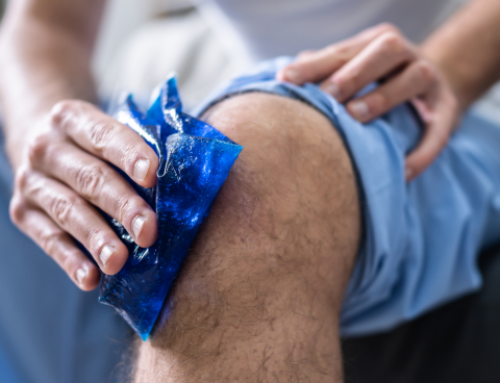The Most Underutilized Piece of Equipment for Healthy Shoulders
Since it does so much pushing, pulling, throwing and lifting, both in everyday life and in the gym, the shoulder joint takes a beating. And since it has the largest range of motion of any joint in the body, the shoulder can be injured if it lacks proper stabilization and strength. The typical approach to rehabilitating a patient with a shoulder injury is relatively similar, regardless of who does the therapy. The main goals are to reduce pain and restore function; in other words, patients should be able to use their shoulder like they did before the injury. Dumbbells, bands, stretching, ultrasound, electrical stimulation and massage are all applied to reduce pain. Unfortunately, most practitioners stop there. To restore function but also prevent re-injury, treatment should go further. In fact, one of the most effective tools for improving shoulder function, the kettlebell, is often overlooked.
Some rehab professionals push back, arguing that the kettlebell is for performance, not rehabilitation. They may even feel that they would be putting their patients at risk by incorporating kettlebells into their workouts. I look at rehabilitation through the eyes of a strength coach. Like many, I believe in integrating total-body movements in a rehabilitation protocol. The shoulder does not act alone. The entire body is involved in lifting, pulling, and pushing. The kettlebell is a training tool that has helped produce elite athletes, soldiers, and law enforcement personnel for years through its integrated, whole body stimulus. Unfortunately, the rehabilitation community is slow to embrace the versatility of this highly effective tool. I believe the kettlebell could become the premier tool for improving stability, strength, mobility and function in most sports medicine and orthopedic settings. Compared to a dumbbell, it is harder to control, because a kettlebell is in constant motion during a lift, resulting in a strong and stable shoulder joint.
Whether for reconditioning an injured shoulder or training an athletic team, kettlebell exercises can be a great addition to improve performance. By forcing the lifter to control the weight and momentum, they build strength, power, and stability. Add the following kettlebell exercises to your routine to prevent injury or rehabilitate a shoulder injury.
Floor Press
The Floor Press is underrated as a shoulder exercise. It is excellent for retraining the chest and shoulder without putting undo stress on the biceps and pectoral tendons, because the floor prevents too much range of motion. The beauty of the exercise is that the lifter must control the kettlebell, which stimulates proprioceptors and promotes shoulder stability. Because of its shape, a kettlebell is more difficult to use than a dumbbell, but it is safer than performing a traditional Bench Press due to the limited range of motion.
[youtube video=”oLcSE9uVALE” /]Half Get-Up
The Half Get-Up is a portion of the traditional Turkish Get-Up.. The challenge of keeping the kettlebell overhead while the body is moving develops great shoulder stability and mobility, as well as core strength. This exercise has proven effective when rehabilitating shoulder impingement, rotator cuff injuries, and labral tears. The Half Get-Up is a safe and effective way to introduce patients to the benefits of the full Turkish Get-Up with limited range of motion.
[youtube video=”eIVLHMB3rqs” /]Slingshots
Slingshots are often used as active recovery exercises or basic juggling movements. The kettlebell is passed around the body from hand to hand. The body should be kept tight with the trunk braced and the gluteal muscles contracted. The Slingshot helps improve shoulder mobility, grip strength, rotator cuff strength, and core strength. It is an active movement, but it can produce a mild traction effect on the shoulder. For patients who have trouble reaching behind their back, this movement can really help, and it’s fun to do.
[youtube video=”Z4r4eHC6Y8M” /]Arm Bar
Although they share the same name, the kettlebell Arm Bar should not be confused with the popular mixed martial arts movement. Start on your back, as in the Turkish Get-Up, and turn away from the hand holding the kettlebell. The goal is to turn toward your chest while keeping the weight pointing towards the ceiling.
The Arm Bar improves flexibility of the pectoral muscles and mobility of the shoulder while enhancing stability throughout the joint. The amount of movement one performs is self-moderated. This is a great exercise for patients with shoulder impingement and rotator cuff repairs at the end stage of rehab to promote greater range of motion.
[youtube video=”yAI9AxyDGIA” /]Kettlebell Swings
The Kettlebell Swing is a basic ballistic movement. It greatly enhances overall body power, hip strength, eccentric hamstring strength, and low back endurance. Since the hips generate most of the movement of the kettlebell, the arms and shoulder joint aren’t under much stress, making it a safe exercise for those with shoulder injuries. Important bonuses: greater grip strength and kinesthetic awareness.
Rehabilitation professionals can look at the Kettlebell Swing like a Codman’s pendulum exercise. The exercise is not suited for everyone who comes into the clinic, but with the proper teaching progression, it can improve mobility and durability of the shoulder joint while simultaneously improving total body conditioning. Clinicians should consider it the next time they are treating someone with shoulder impingement or a person who has begun showing signs of adhesive capsulitis.
[youtube video=”as04cW_a-jA” /]Kettlebell training can be extremely beneficial for those suffering from shoulder pain to help rehab an injury, but also to build strength and stability to prevent future damage. Those involved with rehabilitation of orthopedic or sports injuries should consider incorporating kettlebell exercises in their rehabilitation protocols. In the end, patients will benefit and come back feeling stronger than before. Use the exercises above and educate clients on proper form to reap the biggest benefits from kettlebell training in a rehab setting.
Find more kettlebell movements to implement into your workout through STACK.com/Kettlebell-Exercises.
RECOMMENDED FOR YOU
The Most Underutilized Piece of Equipment for Healthy Shoulders
Since it does so much pushing, pulling, throwing and lifting, both in everyday life and in the gym, the shoulder joint takes a beating. And since it has the largest range of motion of any joint in the body, the shoulder can be injured if it lacks proper stabilization and strength. The typical approach to rehabilitating a patient with a shoulder injury is relatively similar, regardless of who does the therapy. The main goals are to reduce pain and restore function; in other words, patients should be able to use their shoulder like they did before the injury. Dumbbells, bands, stretching, ultrasound, electrical stimulation and massage are all applied to reduce pain. Unfortunately, most practitioners stop there. To restore function but also prevent re-injury, treatment should go further. In fact, one of the most effective tools for improving shoulder function, the kettlebell, is often overlooked.
Some rehab professionals push back, arguing that the kettlebell is for performance, not rehabilitation. They may even feel that they would be putting their patients at risk by incorporating kettlebells into their workouts. I look at rehabilitation through the eyes of a strength coach. Like many, I believe in integrating total-body movements in a rehabilitation protocol. The shoulder does not act alone. The entire body is involved in lifting, pulling, and pushing. The kettlebell is a training tool that has helped produce elite athletes, soldiers, and law enforcement personnel for years through its integrated, whole body stimulus. Unfortunately, the rehabilitation community is slow to embrace the versatility of this highly effective tool. I believe the kettlebell could become the premier tool for improving stability, strength, mobility and function in most sports medicine and orthopedic settings. Compared to a dumbbell, it is harder to control, because a kettlebell is in constant motion during a lift, resulting in a strong and stable shoulder joint.
Whether for reconditioning an injured shoulder or training an athletic team, kettlebell exercises can be a great addition to improve performance. By forcing the lifter to control the weight and momentum, they build strength, power, and stability. Add the following kettlebell exercises to your routine to prevent injury or rehabilitate a shoulder injury.
Floor Press
The Floor Press is underrated as a shoulder exercise. It is excellent for retraining the chest and shoulder without putting undo stress on the biceps and pectoral tendons, because the floor prevents too much range of motion. The beauty of the exercise is that the lifter must control the kettlebell, which stimulates proprioceptors and promotes shoulder stability. Because of its shape, a kettlebell is more difficult to use than a dumbbell, but it is safer than performing a traditional Bench Press due to the limited range of motion.
[youtube video=”oLcSE9uVALE” /]Half Get-Up
The Half Get-Up is a portion of the traditional Turkish Get-Up.. The challenge of keeping the kettlebell overhead while the body is moving develops great shoulder stability and mobility, as well as core strength. This exercise has proven effective when rehabilitating shoulder impingement, rotator cuff injuries, and labral tears. The Half Get-Up is a safe and effective way to introduce patients to the benefits of the full Turkish Get-Up with limited range of motion.
[youtube video=”eIVLHMB3rqs” /]Slingshots
Slingshots are often used as active recovery exercises or basic juggling movements. The kettlebell is passed around the body from hand to hand. The body should be kept tight with the trunk braced and the gluteal muscles contracted. The Slingshot helps improve shoulder mobility, grip strength, rotator cuff strength, and core strength. It is an active movement, but it can produce a mild traction effect on the shoulder. For patients who have trouble reaching behind their back, this movement can really help, and it’s fun to do.
Arm Bar
Although they share the same name, the kettlebell Arm Bar should not be confused with the popular mixed martial arts movement. Start on your back, as in the Turkish Get-Up, and turn away from the hand holding the kettlebell. The goal is to turn toward your chest while keeping the weight pointing towards the ceiling.
The Arm Bar improves flexibility of the pectoral muscles and mobility of the shoulder while enhancing stability throughout the joint. The amount of movement one performs is self-moderated. This is a great exercise for patients with shoulder impingement and rotator cuff repairs at the end stage of rehab to promote greater range of motion.
[youtube video=”yAI9AxyDGIA” /]Kettlebell Swings
The Kettlebell Swing is a basic ballistic movement. It greatly enhances overall body power, hip strength, eccentric hamstring strength, and low back endurance. Since the hips generate most of the movement of the kettlebell, the arms and shoulder joint aren’t under much stress, making it a safe exercise for those with shoulder injuries. Important bonuses: greater grip strength and kinesthetic awareness.
Rehabilitation professionals can look at the Kettlebell Swing like a Codman’s pendulum exercise. The exercise is not suited for everyone who comes into the clinic, but with the proper teaching progression, it can improve mobility and durability of the shoulder joint while simultaneously improving total body conditioning. Clinicians should consider it the next time they are treating someone with shoulder impingement or a person who has begun showing signs of adhesive capsulitis.
Kettlebell training can be extremely beneficial for those suffering from shoulder pain to help rehab an injury, but also to build strength and stability to prevent future damage. Those involved with rehabilitation of orthopedic or sports injuries should consider incorporating kettlebell exercises in their rehabilitation protocols. In the end, patients will benefit and come back feeling stronger than before. Use the exercises above and educate clients on proper form to reap the biggest benefits from kettlebell training in a rehab setting.
Find more kettlebell movements to implement into your workout through STACK.com/Kettlebell-Exercises.











